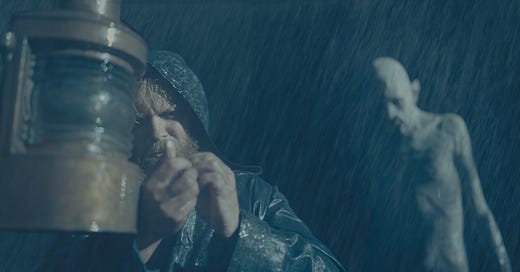“Dracula on a boat” seems like an odd but good-enough premise for a horror flick. I’ll admit that when I first saw the trailer for The Last Voyage of the Demeter, I was intrigued. The old-timey, maritimey aesthetic and monster mayhem seemed like a compelling recipe for a wild ride of fear and paranoia on the high seas.
Then again, the trailer showed way more of its central fiend than I would’ve cared to see ahead of the actual film, and some asshole in Universal Pictures’ marketing department thought The Smashing Pumpkins’ “Bullet with Butterfly Wings” would make a good needle drop, solely for the lyric, “the world is a vampire.” They were probably very satisfied with themselves, but every time I saw the trailer in a theater, someone in the audience would snicker or groan. Rightly so.
Unfortunately, the film is neither as interesting as its premise nor as trashy as the Universal marketing team. Either would have been preferable to the dull, non-committal gesture we got.
Voyage shows signs of rough waters from the start. Our introduction to the story is a text card that tells us about a derelict ship, the Demeter, that came crashing ashore in England in the last 19th century, and that this is the story of what happened on that ship. We are then treated to a sequence that shows exactly this: a derelict ship, the Demeter, crashing ashore in England. Two minutes into the film and we’re already awash in redundancy.
The preceding text card also explains that this story is based on Bram Stoker’s novel Dracula, which just kind of takes any oomph out of the feigned “based on a true story” wording of the introduction, as well as the name-drop later in the film, which is treated as a reveal—especially funny in-context, as no one on the boat knows who Dracula is besides the person who reveals his name.
After being told the Demeter crashed, then seeing the Demeter crash, and being told Dracula was on the ship, we rewind several days to the start of the Demeter’s journey. Captain Eliot (Liam Cunningham) and his first mate Wojchek (David Dastmalchian) are gathering up a crew in Romania to transport cargo to England. An educated man named Clemens (Corey Hawkins) eagerly volunteers himself, but Wojchek rejects him, saying they’d rather have strong, experienced men than intellectuals.
Clemens’ luck turns around when one of Eliot’s new recruits almost kills his grandson with an out-of-control shipping crate. Apparently, the new recruit, a Romanian local, was spooked by the ominous dragon iconography emblazoned on the crate. He’s quickly dismissed, and Clemens takes his spot. And the Demeter sets sail.
Of course, the ominous dragon crate houses Dracula, and we already know that the crew is doomed, thanks to the double-introduction. What ensues is something like Alien, if the Xenomorph was a vampire, the space ship was a sailing ship, and the movie was boring.
Night after night, Dracula stalks the ship, feasting on one seaman at a time. One positive note about this is the way Dracula himself is revealed. It’s an impressive monster design, brought to life largely with practical effects worn by Javier Botet, whom you may know as Mama in Mama, the Crooked Man in The Conjuring 2, or the Hobo in It and Chapter 2. He’s a very talented creature actor, and at least early on, the film does a good job showing glimpses of him without revealing his whole form.
But this positive note is nearly lost in the awkward editing of each kill. Characters seem to teleport within the scene’s geography from one shot to the next, making it difficult to follow the sequences in which the vampire stalks them. Any scare factor is obviously lost as well. Some admirable quantities of blood and gore are restrained by chaste camera angles and overzealous cuts.
The script, by Bragi F. Schut and Zak Olkewicz, attempts something of a philosophical arc for Clemens, clumsily juxtaposing his social status as a Black man in 19th-century Europe against his academic quest to “make sense of this world,” and thusly also make sense of this unfamiliar beast that hunts them. Ultimately, it’s frivolous, as director André Øvredal has little interest in dedicating enough time to it to make it meaningful.
This would be fine if the film at least focused on building tension amongst the crew. For a film that takes so many structural notes from Alien and The Thing, it’s awfully ignorant to what makes those movies suspenseful. Where’s the paranoia? The mistrust? The evaporation of dignity in the face of certain doom?
There are shreds of this toward the beginning of the journey, but that tension is quickly lost as crew members are picked off. Had I gotten to know any of them, maybe I’d have felt sad when they died, or overjoyed that they got what was coming to them. But the film remains as neutral as possible on just about every front. Not too much blood, not too scary, not too emotional, not too philosophical.
The Last Voyage of the Demeter is mostly just bland. We’re told (doubly) of the story’s endpoint straight away, and we know Dracula is the culprit. Between these foregone conclusions, the lack of thrills in the kills, and the absence of drama between characters, there’s little to discover along the way.
Only the most passionate vampire enthusiasts will get anything out of “Dracula on a boat.” Most would likely have a better time with Snakes on a Plane.





